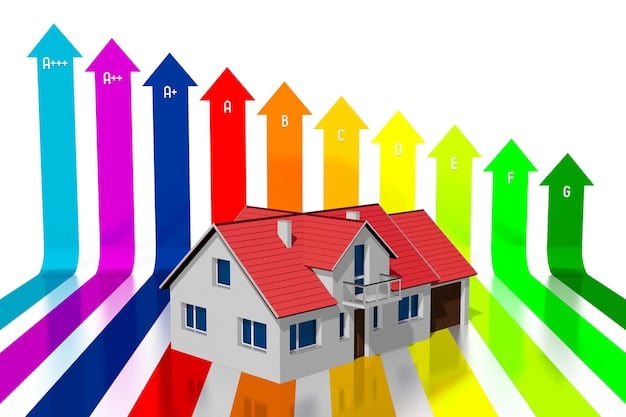Refinance Now? Impact of 7% Mortgage Rates Analyzed

Refinancing your mortgage at the current 7% interest rates requires careful analysis of its impact on your monthly payments, considering potential savings versus the costs involved in the refinance process.
Navigating the world of mortgages can be complex, especially when interest rates fluctuate. With current mortgage rates hovering around 7%, many homeowners are wondering: Is now the right time to refinance your mortgage? Analyzing the impact of current 7% interest rates on your monthly payments is crucial before making any decisions.
Understanding Current Mortgage Rate Trends
To make an informed decision about refinancing, it’s essential to grasp the current trends in mortgage rates. These rates are influenced by a variety of economic factors.
Understanding these factors can help you anticipate future rate movements and decide whether to refinance now or wait for potentially more favorable conditions.
Factors Influencing Mortgage Rates
Mortgage rates don’t exist in a vacuum. Several key factors contribute to their rise and fall.
- Economic Growth: Strong economic growth often leads to higher interest rates as demand for capital increases.
- Inflation: Rising inflation typically pushes mortgage rates upward as lenders seek to maintain their real returns.
- Federal Reserve Policy: The Federal Reserve’s monetary policy decisions, such as adjusting the federal funds rate, significantly impact mortgage rates.
- Bond Market: Mortgage rates are closely tied to the yield on 10-year Treasury bonds, which reflects investor confidence in the economy.
Keeping an eye on these economic indicators will provide valuable insights into the direction of mortgage rates.

In conclusion, comprehending the factors that influence mortgage rates is crucial for anyone contemplating a refinance. By staying informed about economic growth, inflation, Federal Reserve policy, and the bond market, homeowners can better anticipate rate movements and make strategic decisions.
Calculating Your Potential Savings
The primary motivation behind refinancing is often to save money. But how do you determine if refinancing at 7% will actually result in savings?
Calculating your potential savings involves comparing your current mortgage terms with the terms of a new loan at the prevailing interest rate.
Comparing Current vs. New Loan Terms
The first step is to gather all the details of your existing mortgage. This includes:
- Current Interest Rate: The interest rate you are currently paying on your mortgage.
- Remaining Loan Balance: The outstanding principal amount you still owe.
- Loan Term: The original length of your mortgage and how many years are remaining.
- Monthly Payment: The total amount you pay each month, including principal, interest, taxes, and insurance (PITI).
Once you have this information, you can compare it to the terms you could potentially obtain with a new loan at a 7% interest rate.
Using Mortgage Refinance Calculators
Several online mortgage refinance calculators can help you estimate your potential savings. These calculators typically require you to input:
- Current Loan Balance
- Current Interest Rate
- New Interest Rate (7%)
- Loan Term
The calculator will then provide an estimate of your new monthly payment and the total interest you would pay over the life of the loan. Comparing these figures with your current mortgage terms will reveal whether refinancing makes financial sense.
In summary, calculating your potential savings from refinancing involves carefully comparing your current mortgage terms to those of a new loan at 7%. Utilizing online mortgage refinance calculators can streamline this process and provide valuable insights into the financial implications of refinancing.
Weighing the Costs of Refinancing
While the prospect of lower monthly payments is appealing, refinancing isn’t free. It’s essential to consider the costs associated with refinancing and determine whether they outweigh the potential savings.
These costs can include appraisal fees, origination fees, title insurance, and other closing costs.

Types of Refinancing Costs
Refinancing costs can vary depending on the lender and the type of loan. Common expenses include:
- Appraisal Fee: This fee covers the cost of assessing the current market value of your home.
- Origination Fee: Lenders charge this fee to cover the cost of processing your loan application.
- Title Insurance: This protects the lender against any claims against the property’s title.
- Closing Costs: These include various fees for services such as credit checks, recording fees, and attorney fees.
Be sure to get a detailed estimate of all refinancing costs from your lender.
Calculating the Break-Even Point
To determine if refinancing is worthwhile, calculate the break-even point – the amount of time it will take for your savings to offset the refinancing costs. Here’s how:
- Total Refinancing Costs: Add up all the expenses associated with refinancing.
- Monthly Savings: Calculate the difference between your current monthly payment and your estimated new monthly payment.
- Break-Even Point: Divide the total refinancing costs by the monthly savings. The result is the number of months it will take to recoup the costs.
If you plan to stay in your home longer than the break-even point, refinancing may be a good option. If not, it may be better to explore other strategies.
In summary, weighing the costs of refinancing is a crucial step in the decision-making process. By understanding the types of costs involved and calculating the break-even point, homeowners can determine whether the potential savings justify the expense of refinancing.
Exploring Alternative Mortgage Options
If refinancing at 7% doesn’t seem like the best fit for your financial situation, there are alternative mortgage options to consider.
These options may provide different ways to lower your monthly payments or achieve your financial goals.
Adjustable-Rate Mortgages (ARMs)
ARMs typically offer a lower initial interest rate compared to fixed-rate mortgages. However, the rate can adjust periodically based on market conditions, potentially leading to higher payments in the future.
Home Equity Line of Credit (HELOC)
A HELOC allows you to borrow against the equity in your home. It can be used for various purposes, such as home improvements or debt consolidation. Interest rates on HELOCs are usually variable.
Making Extra Principal Payments
An often overlooked option is to simply make extra principal payments on your current mortgage. This can shorten the loan term and reduce the total interest paid without the costs associated with refinancing.
Exploring these alternative mortgage options can provide homeowners with greater flexibility and control over their finances.
In conclusion, alternative mortgage options offer a range of solutions for homeowners seeking to manage their mortgage payments and achieve their financial objectives. By considering options such as ARMs, HELOCs, and making extra principal payments, individuals can find the approach that best aligns with their needs and circumstances.
The Long-Term Financial Implications
Refinancing your mortgage is a significant financial decision with long-term implications. It’s important to consider how refinancing will affect your overall financial well-being.
Factors such as your long-term financial goals, risk tolerance, and future income prospects should be taken into account.
Impact on Debt-to-Income Ratio
Refinancing can impact your debt-to-income ratio (DTI), which is the percentage of your gross monthly income that goes towards debt payments. A lower DTI indicates better financial health and can make it easier to qualify for other loans in the future.
Building Equity Faster
If you refinance to a shorter loan term, you’ll likely build equity in your home faster. This can be beneficial if you plan to sell your home in the near future or want to tap into your equity for other investments.
Potential Tax Benefits
Mortgage interest is often tax-deductible, which can reduce your overall tax liability. However, tax laws can change, so it’s important to consult with a tax advisor to understand the potential tax benefits of refinancing.
Understanding the long-term financial implications of refinancing can help you make a more informed decision that aligns with your financial goals.
In conclusion, understanding the long-term financial implications is a crucial aspect of the refinancing decision. By considering factors such as debt-to-income ratio, equity building, and potential tax benefits, homeowners can make a well-informed choice that supports their financial well-being.
Seeking Professional Advice
Given the complexities of mortgage refinancing, seeking professional advice can be invaluable. A qualified financial advisor or mortgage broker can provide personalized guidance based on your specific circumstances.
They can help you evaluate your options, understand the risks and benefits, and make a decision that aligns with your financial goals.
Consulting a Financial Advisor
A financial advisor can assess your overall financial situation and help you determine if refinancing fits into your long-term financial plan. They can also provide insights into other financial strategies that may be beneficial.
Working with a Mortgage Broker
A mortgage broker can shop around for the best interest rates and loan terms from multiple lenders. They can also help you navigate the loan application process and ensure you get the best possible deal.
Understanding Loan Estimates
Be sure to obtain a Loan Estimate from any lender you are considering. This document provides a detailed breakdown of the loan terms, interest rate, and all associated costs. Compare Loan Estimates from multiple lenders to find the most favorable offer.
In summary, seeking professional advice is a wise step in the mortgage refinancing process. Whether consulting a financial advisor or working with a mortgage broker, expert guidance can help homeowners navigate the complexities of refinancing and make well-informed decisions that align with their financial goals.
| Key Aspect | Brief Description |
|---|---|
| 💰 Savings Potential | Calculate savings by comparing current loan terms with a 7% refinance. |
| ⚖️ Weighing Costs | Consider appraisal, origination, and closing costs. Calculate the break-even point. |
| 📊 Alternative Options | Explore ARMs, HELOCs, or extra principal payments. |
| 🤝 Professional Advice | Consult financial advisors or mortgage brokers for guidance. |
Frequently Asked Questions (FAQ)
▼
Mortgage rates are influenced by economic growth, inflation, Federal Reserve policy, and the bond market, particularly the yield on 10-year Treasury bonds.
▼
Compare your current interest rate, remaining loan balance, and loan term with potential new terms at a 7% interest rate. Use online calculators for estimations.
▼
Costs include appraisal fees, origination fees, title insurance, and closing costs. Obtain a detailed estimate from your lender to calculate the total expenses.
▼
Alternatives include Adjustable-Rate Mortgages (ARMs), Home Equity Lines of Credit (HELOCs), and making extra principal payments on your current mortgage.
▼
Financial advisors and mortgage brokers can offer personalized guidance, helping you understand the risks and benefits, and aligning the decision with your financial goals.
Conclusion
Deciding whether to refinance your mortgage at the current 7% interest rates is a complex decision that requires careful consideration of your financial situation, potential savings, associated costs, and long-term goals. By thoroughly analyzing all these factors and seeking professional advice, you can make an informed decision that best suits your needs.





